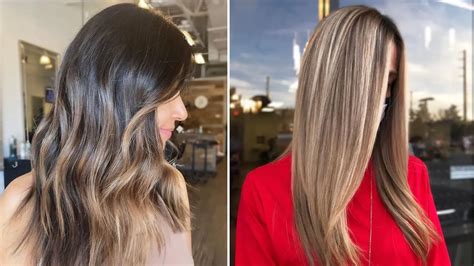Whether you’re looking to refresh your hair with subtle color or make a bold statement, balayage and highlights are two popular techniques to elevate your dark locks. But what’s the difference between these techniques, and which one is right for you? Here’s a comprehensive comparison to guide your decision:

1. What is Balayage?
Balayage is a freehand painting technique that translates to “to sweep” in French. The color is applied to the surface of the hair, creating natural-looking, sun-kissed highlights. Unlike traditional highlights, balayage involves no foils or caps, allowing for a seamless blend of light and dark tones.
2. What is Highlights?
Highlights involve lifting the hair with bleach or color to create lighter strands that contrast with the rest of the hair. Traditional highlights use foils or caps to isolate sections of hair, resulting in a more defined, striped effect. Foils enhance the lifting process, leading to brighter, more noticeable highlights.
3. Balayage vs. Highlights: Key Differences
| Feature | Balayage | Highlights |
|---|---|---|
| Technique | Freehand painting | Foils or caps |
| Result | Natural-looking highlights, seamless blend | Defined, striped highlights, brighter contrast |
| Maintenance | Low maintenance, grows out gracefully | Requires regular touch-ups to maintain contrast |
| Cost | Can be more expensive due to time and skill required | Generally less expensive than balayage |
4. Which One is Right for You?
The choice between balayage and highlights depends on your desired look and lifestyle:
- Balayage suits those seeking a subtle, low-maintenance color change. Its natural-looking blend minimizes the appearance of roots and requires less frequent touch-ups.
- Highlights are ideal for a more dramatic, contrasting effect. They require regular maintenance but can brighten up dark hair significantly.
5. Tips and Tricks
- Consider your hair texture: Balayage can be challenging on fine hair, as it may not provide enough volume. Highlights are a better option for adding dimension and body.
- Discuss your goals with your stylist: Communicate your desired look and maintenance preferences to ensure the technique aligns with your needs.
- Protect your color: Use color-protecting shampoos and conditioners to preserve the vibrancy of your highlights or balayage.
6. How to Choose a Stylist
- Look for experience: Choose a stylist who specializes in balayage or highlights on dark hair and has a portfolio showcasing their work.
- Read reviews: Check online reviews to assess past clients’ experiences and the quality of the stylist’s work.
- Book a consultation: Schedule a consultation to discuss your hair goals, expectations, and to determine if the stylist is a good fit for your needs.
7. Cost Comparison
The cost of balayage and highlights varies depending on factors such as hair length, density, and stylist experience. Generally:
| Length | Balayage | Highlights |
|---|---|---|
| Short hair | $150-$300 | $100-$250 |
| Medium hair | $250-$400 | $150-$300 |
| Long hair | $350-$500 | $200-$400 |
8. Pain Points
- Balayage: Can be time-consuming due to the freehand application, potentially leading to longer salon visits.
- Highlights: Requires regular touch-ups to maintain contrast, which can be costly and damaging to hair.
9. Motivations
- Balayage: Natural-looking highlights, low maintenance, sun-kissed effect.
- Highlights: Bold contrast, brighter effect, dramatic transformation.
10. Conclusion
Both balayage and highlights offer unique advantages for enhancing dark hair. Balayage creates a seamless blend for a natural-looking result, while highlights provide a defined contrast for a more striking effect. Consider your desired outcome, maintenance preferences, and budget to determine the technique that best suits your needs. By working closely with an experienced stylist, you can achieve stunning highlights or balayage that complements your hair and enhances your overall style.
